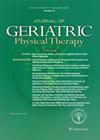A New Approach to Individualize Physical Activity Interventions for Individuals With Dementia: Cluster Analysis Based on Physical and Cognitive Performance.
IF 1.8
4区 医学
Q4 GERIATRICS & GERONTOLOGY
引用次数: 0
Abstract
BACKGROUND AND PURPOSE Physical activity (PA) can have a beneficial effect on cognitive and physical performance in individuals with dementia (IWD), including those residing in nursing homes. However, PA interventions in nursing homes are usually delivered using a group setting, which may limit the effectiveness of the intervention due to the heterogenous nature of IWD. Therefore, the purpose of this study was to identify clusters based on cognitive and physical performance values, which could be used to improve individualization of PA interventions. METHODS Based on the cognitive and physical performance variables of 230 IWD, a cluster analysis was conducted. Global cognition (Mini-Mental State Examination), mobility (6-Meter Walking Test), balance (Frailty and Injuries: Cooperative Studies of Intervention Techniques-subtest-4), and strength and function of lower extremities (30-Second Chair-Stand Test) were assessed, and values were used to perform a hierarchical cluster analysis with Ward's method. Differences in physical and cognitive performance as well as other secondary outcomes (age, sex, body mass index, use of walking aids, diagnosis and etiology of dementia, number of medications, and Cumulative Illness Rating Scale) were tested using 1-factorial analyses of variance. RESULTS AND DISCUSSION Out of 230 data sets, 3-cluster solutions were identified with similar cluster sizes of 73 to 79. The silhouette coefficients for all calculated clusters ranged between 0.15 and 0.34. The cluster solutions were discussed in the context of cognitive and physical functions as well as training modalities and opportunities. The 4-cluster solution appears to be best suited for providing or developing an individualized PA intervention. CONCLUSIONS The identified clusters of the 4-cluster solution may be used in future research to improve individualization of dementia-specific PA interventions. By assigning IWD to these clusters, more homogenous groups with regard to cognitive and physical performance can be formed. This allows for more individualized PA interventions and may result in a higher effectiveness, particularly in nursing homes. Our findings are relevant for therapists and nursing staff who design or deliver PA interventions in nursing homes or similar settings.痴呆症患者个体化体育活动干预的新方法:基于身体和认知表现的聚类分析。
背景和目的:体育活动(PA)可以对痴呆症(IWD)患者的认知和身体表现产生有益影响,包括那些住在疗养院的人。然而,养老院的PA干预通常是在集体环境中进行的,由于IWD的异质性,这可能会限制干预的有效性。因此,本研究的目的是根据认知和身体表现值确定集群,可用于提高PA干预的个性化。方法:以230名IWD患者的认知和身体表现变量为基础,进行聚类分析。评估了整体认知(迷你精神状态检查)、行动能力(6米步行测试)、平衡能力(虚弱和损伤:干预技术的合作研究-子测试-4)以及下肢力量和功能(30秒椅子站立测试),并使用这些值用Ward方法进行分层聚类分析。使用1因子方差分析测试了身体和认知表现以及其他次要结果(年龄、性别、体重指数、助行器的使用、痴呆症的诊断和病因、药物数量和累积疾病评定量表)的差异。结果和讨论:在230个数据集中,确定了具有73至79个相似聚类大小的3聚类解决方案。所有计算集群的轮廓系数在0.15和0.34之间。在认知和身体功能以及训练模式和机会的背景下讨论了集群解决方案。4簇解决方案似乎最适合提供或开发个性化PA干预。结论:确定的4簇溶液簇可用于未来的研究,以提高痴呆症特异性PA干预的个性化。通过将IWD分配给这些集群,可以在认知和身体表现方面形成更同质的群体。这允许更个性化的PA干预,并可能产生更高的效果,尤其是在养老院。我们的研究结果与在疗养院或类似环境中设计或提供PA干预的治疗师和护理人员有关。
本文章由计算机程序翻译,如有差异,请以英文原文为准。
求助全文
约1分钟内获得全文
求助全文
来源期刊

Journal of Geriatric Physical Therapy
GERIATRICS & GERONTOLOGY-REHABILITATION
CiteScore
3.70
自引率
4.20%
发文量
58
审稿时长
>12 weeks
期刊介绍:
Journal of Geriatric Physical Therapy is the leading source of clinically applicable evidence for achieving optimal health, wellness, mobility, and physical function across the continuum of health status for the aging adult.
The mission of the Academy of Geriatric Physical Therapy is building a community that advances the profession of physical therapy to optimize the experience of aging.
 求助内容:
求助内容: 应助结果提醒方式:
应助结果提醒方式:


